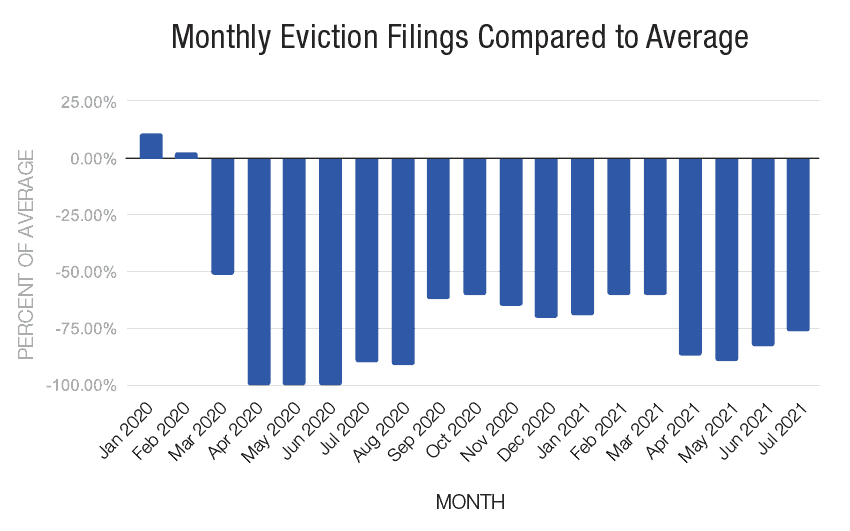The COVID-19 pandemic has resulted in a crisis for renters and small landlords as missing rent payments have driven both to the brink. Eviction moratoria and rental assistance programs have been effective, but remain confusing to consumers and too small for the scale of the crisis that looms now that most jurisdictions are allowing evictions to commence.
Pennsylvania enacted a moratorium on evictions in early spring of 2020. Subsequently, the Centers for Disease Control and Prevention also issued an order for a federal eviction moratorium that has been extended several times and is now set to expire on Oct. 3, 2021.
In June 2021, a coalition of Philadelphia housing advocates asked the National Community Reinvestment Coalition (NCRC) to gauge the scale of the eviction crisis in their city. What we found was that in 2020 the number of evictions in Philadelphia was a fraction of previous years. Based on this decrease in evictions, and the evidence that many renters owe back rent due to the pandemic, Philadelphia may face a flood of new eviction orders when the moratorium ends.
Using data from the Princeton Eviction Lab and Philadelphia Legal Assistance, NCRC’s research team created the Eviction Risk Index, which estimates which census tracts are expected to see the most evictions based on historical data and other factors. This was presented alongside an estimation of deferred evictions as of June 1, 2021. The index quantified the expected risk of eviction at the census tract level based on historical eviction data, income, race and other factors to present a more detailed tool for the public to target rental and eviction assistance where it is most needed.
NCRC’s Eviction Risk Index for all Census tracts in the City of Philadelphia, PA.
Click each Census tract for more information regarding socioeconomic and eviction data.
Source: ACS (2016-2019)
The Pennsylvania and CDC eviction moratoria corresponds with a large reduction in the number of evictions in Philadelphia as seen in the percent below average in Figure 1. The moratorium is likely to have preserved the housing stability of tenants during a time of global crisis, reducing the risk of exposure to disease by limiting forcible moves, and lessening economic hardship.
There is concern, however, that once the moratoriums are lifted there will be a surge in eviction orders, jeopardizing the housing stability of tenants and neighborhoods throughout the city. As of July 10, 2021, we estimated that citywide, over 21,500 evictions may have been deferred during the pandemic. Will the deferred evictions, in addition to the financial hardship of the pandemic, result in increased evictions in the future, and which neighborhoods are most likely to be impacted?
Figure 1. Philadelphia monthly eviction rate during the moratorium compared to the average monthly rate, (Source: Evictionlab https://evictionlab.org/eviction-tracking/philadelphia-pa/ )
As the eviction moratorium in Philadelphia comes to an end, the ERI offers a glimpse of where evictions will be concentrated and who will bear the brunt of this crisis. A flood of new eviction orders is possible, depending on the ability of the court system to process evictions and support for renters and landlords. The evictions would largely impact the most vulnerable populations: racial and ethnic minorities and low income families, living in neighborhoods with higher proportions of rental properties. The potential impact of this crisis on both tenants and small landlords is high, and we hope that this tool helps both city leadership and the people of Philadelphia understand both the scale and the geography of this threat as they work together to head off widespread evictions.
Figure 2 shows a ranking of Philadelphia neighborhoods, with those at highest risk in red and lowest risk in blue. The Eviction Risk Index is presented side-by-side with a map of evictions between 2016 and 2019 in Philadelphia. The data indicated that there are lower levels of risk for increased evictions in the downtown core area due to the high median household income, lower percentage of renters, and lower percentages of more vulnerable minority residents residing in the area. There are very high levels of exposure to eviction in the area west of downtown and across the Schuylkill River of University City, then to the north of downtown, encompassing North Philadelphia East and West, and Upper North Philadelphia. The areas most at risk and rated as “very high” have a combination of high renter occupancy, low median household income, and high percentages of minority residents. A few of the neighborhoods assessed with the highest risk levels encompass Wynnefield Heights, which has 99 to 100% renter occupancy, a factor that in and of itself has a potential to drive up eviction levels.
Figure 2. The Eviction Risk Index ranked by quintile from lowest to highest and areas of past evictions based on 2016-2019 data. (Source: Author’s calculation of the index and past evictions provided by Eviction Lab https://evictionlab.org/eviction-tracking/philadelphia-pa/.)
Mapping of the Eviction Risk Index provides the data to identify and locate neighborhoods where eviction may present a greater challenge to renters. The ERI is a tool for advocacy groups wishing to concentrate and apply effort and resources to specific neighborhoods as the nation emerges from the pandemic. As of July 2021, the U.S. Census Pulse Survey reported that 16% of renters were still behind on their rent across the country. For Black and Hispanic renters, this figure was 24% and 18%, respectively. The Urban Institute noted in February that the total amount of back rent owed by renters was as high as $52.6 billion. Even before the pandemic, housing stock was at a low level creating issues of affordability and housing quality.There have been indications of hikes in rents as cities emerge from the pandemic. The neighborhoods with high Eviction Risk Index values house the most vulnerable population in Philadelphia. The combination of deferred evictions, a shortage of affordable housing, and increasing demand – especially in neighborhoods that are ripe for gentrification- presents a considerable challenge to low and moderate income renters in Philadelphia.




